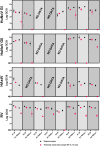Presence of Potentially Infectious Human Enteric Viruses and Antibiotic Resistance Genes in Mussels from the Campania Region, Italy: Implications for Consumer's Safety
- PMID: 40372520
- PMCID: PMC12081582
- DOI: 10.1007/s12560-025-09635-5
Presence of Potentially Infectious Human Enteric Viruses and Antibiotic Resistance Genes in Mussels from the Campania Region, Italy: Implications for Consumer's Safety
Abstract
This study presents a comprehensive assessment of viral contamination and antibiotic resistance genes (ARGs) presence in mussels (Mytilus galloprovincialis) (n = 60) collected from retail stores in the Campania region (Italy). High prevalence of human noroviruses (HuNoV) genogroup I (GI) (77%) and genogroup II (GII) (40%), rotaviruses (RV) (60%), and astroviruses (HAstV) (25%) was found, with average levels of 4.34, 5.09, 5.05, and 4.00 Log genome copies (GC)/g, respectively. All samples tested negative for hepatitis A and E viruses. Viral faecal contamination indicators, including somatic coliphages (88%, 3.62 mean Log plaque forming units (PFU)/100 g) and crAssphage (50%, 3.72 mean Log GC/g), showed strong correlations (ρ > 0.65, p-value < 0.05) with HuNoV GII, HAstV, and RV concentrations in mussels. The study also investigated the presence of respiratory viruses, with all samples testing negative for SARS-CoV-2, respiratory syncytial virus, and influenza A virus.Furthermore, a capsid-integrity RT-qPCR assay was applied to selected positive samples, confirming the presence of potentially infectious viruses and underscoring the associated risks to consumers.Additionally, ARGs were detected by qPCR, targeting beta-lactams, quinolones, and chloramphenicol resistance genes in both the total and the bacteriophage fractions of selected samples.Overall, this study emphasizes the importance of continued surveillance and strategic interventions to mitigate public health risks associated with the consumption of contaminated bivalve molluscan shellfish (BMS), which may imply the dissemination of infectious enteric viruses and ARGs within communities.
Keywords: ARGs; Food safety; Foodborne viruses; Viability RT-qPCR.
© 2025. The Author(s).
Conflict of interest statement
Declarations. Conflict of Interest: The authors declare no competing interests. Consent for Publication: During the preparation of this work, the author(s) used ChatGPT ( https://chat.openai.com/ ) in order to improve readability and language. After using this tool/service, the author(s) reviewed and edited the content as needed and take(s) full responsibility for the content of the publication.
Figures





Similar articles
-
CrAssphage as a Human Enteric Viral Contamination Bioindicator in Marketed Bivalve Mollusks.Viruses. 2025 Jul 18;17(7):1012. doi: 10.3390/v17071012. Viruses. 2025. PMID: 40733628 Free PMC article.
-
Insights Into Pandemic and Post-Pandemic Dynamics of Enteric Viruses in a Middle-Size City-Burgos, Spain-Using a Long-Term Wastewater Surveillance.Food Environ Virol. 2025 Jun 24;17(3):36. doi: 10.1007/s12560-025-09650-6. Food Environ Virol. 2025. PMID: 40555909
-
Occurrence and Molecular Characterization of Human Astrovirus and Hepatitis A Virus in Bivalve Mollusks Marketed in Tourist Cities in Rio de Janeiro, Brazil.Food Environ Virol. 2025 Apr 2;17(2):23. doi: 10.1007/s12560-025-09639-1. Food Environ Virol. 2025. PMID: 40172833
-
A systematic review and meta-analysis indicates a substantial burden of human noroviruses in shellfish worldwide, with GII.4 and GII.2 being the predominant genotypes.Food Microbiol. 2023 Feb;109:104140. doi: 10.1016/j.fm.2022.104140. Epub 2022 Sep 10. Food Microbiol. 2023. PMID: 36309442
-
Occurrence of viruses in sewage sludge: A systematic review.Sci Total Environ. 2022 Jun 10;824:153886. doi: 10.1016/j.scitotenv.2022.153886. Epub 2022 Feb 16. Sci Total Environ. 2022. PMID: 35182626 Free PMC article.
Cited by
-
CrAssphage as a Human Enteric Viral Contamination Bioindicator in Marketed Bivalve Mollusks.Viruses. 2025 Jul 18;17(7):1012. doi: 10.3390/v17071012. Viruses. 2025. PMID: 40733628 Free PMC article.
References
-
- Ahmed, W., Payyappat, S., Cassidy, M., Harrison, N., & Besley, C. (2020). Sewage-associated marker genes illustrate the impact of wet weather overflows and dry weather leakage in urban estuarine waters of Sydney, Australia. Science of the Total Environment,705, 135390. 10.1016/j.scitotenv.2019.135390 - PubMed
-
- Aprea, G., Amoroso, M. G., Di Bartolo, I., D’Alessio, N., Di Sabatino, D., Boni, A., Cioffi, B., D’Angelantonio, D., Scattolini, S., De Sabato, L., Cotturone, G., Pomilio, F., Migliorati, G., Galiero, G., & Fusco, G. (2018). Molecular detection and phylogenetic analysis of hepatitis E virus strains circulating in wild boars in south-central Italy. Transboundary and Emerging Diseases,65, e25–e31. 10.1111/tbed.12661 - PubMed
-
- Atlas, R. M. (2013). One health: Its origins and future. Current Topics in Microbiology and Immunology,365, 1–13. 10.1007/82_2012_223 - PubMed
-
- Bivins, A., Crank, K., Greaves, J., North, D., Wu, Z., & Bibby, K. (2020). Cross-assembly phage and pepper mild mottle virus as viral water quality monitoring tools—potential, research gaps, and way forward. Curr Opin. Environ. Sci. Health,16, 54–61. 10.1016/j.coesh.2020.02.001
MeSH terms
Substances
Grants and funding
LinkOut - more resources
Full Text Sources
Medical
Miscellaneous

